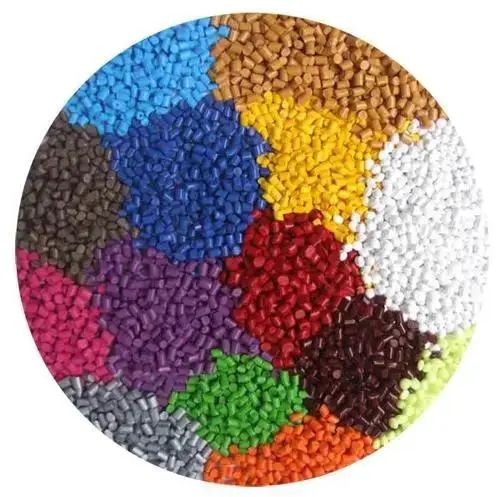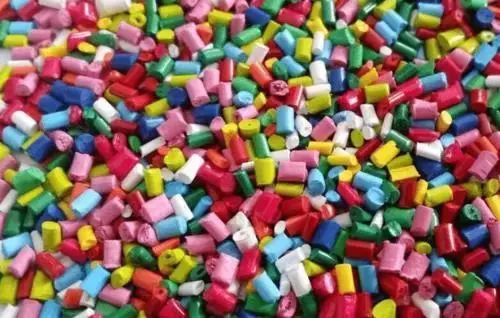Color Masterbatch Classification
1. Depending on the use
Color masterbatch is divided into injection color masterbatch, blow molding color masterbatch, spinning color masterbatch and other varieties can be divided into different grades. High-grade injection masterbatch is used for cosmetic packing box, toy, electrical case and other high-grade products. Advanced blow molding color masterbatch for ultra-thin products blow molding coloring.

Common blow molding color masterbatch for general packaging bags, woven bags blow coloring. Spinning Masterbatch is used for dyeing of textile fibers. The masterbatch pigment has fine particles, high concentration, strong dyeing force, good heat and light resistance. Low-grade masterbatch is used to manufacture low-grade products with low requirements for color quality.
2. Depending on the carrier
It is divided into PE, PP, PVC, PS, ABS, Eva, PC, PET, Pek, Phenol formaldehyde resin, epoxy, acrylic resin, unsaturated polyester resin, polyurethane, polyamide, fluorine resin color masterbatch, etc.
3. According to the different functions
Divided into antistatic, flame retardant, anti-aging, anti-bacterial, whitening brightening, increasing transparency, weather resistance, extinction, pearlescent, imitation marble grain (flow) , wood grain color masterbatch.
4.According to the user usage
It is divided into general color masterbatch and special color masterbatch. Low melting point PE masterbatch is often used as a universal color masterbatch, suitable for other resins besides carrier resin. Most normal color masterbatch enterprises in the world do not produce general color masterbatch, the general range of general color masterbatch is very narrow, technical indicators, poor economic benefits.
General color masterbatch in different plastics show different colors, the color effect of poor predictability. General color masterbatch affects the product strength, the product is easy to deformation, distortion, engineering plastics is more obvious. General color masterbatch for general use, choose higher heat-resistant grade pigments, higher cost, resulting in waste.

Special color masterbatch in the processing of products, with high concentration, good dispersion, cleaning and other significant advantages. The heat-resistant grade of special color masterbatch is suitable for the plastic used in products. It can be used safely at normal temperature, but it will cause discoloration in different degree when the temperature is out of the normal range and the shutdown time is too long.
5. Color
Divided into black, white, yellow, green, red, orange, brown, blue, silver, gold, purple, gray, pink masterbatch and so on.
Color masterbatch basic ingredients
1.Pigments
Pigment is the basic coloring component, it is best to pretreat the surface of its fine particles covered with resin to prevent mutual flocculation, so that it is easy to disperse. For coating and mixing evenly, the solvent which has affinity to pigment and dissolves resin, such as o-dichlorobenzene, chlorobenzene, xylene,etc. When the resin dissolves, the pigment is dispersed and the solvent is recovered or removed.
2.Carrier
The carrier is the matrix of color masterbatch. At present, special color masterbatch uses the same resin as carrier, which can ensure the compatibility of color masterbatch and colored resin, and is conducive to better dispersion of pigments. There are many kinds of carrier resins, such as polyethylene, random polypropylene, poly -LRB-1-butene) , low molecular weight polypropylene and so on.
For polyolefin color masterbatch, LLDPE or LDPE with high melt index is usually used as carrier resin, which has good flowability and can be blended with colored resin to adjust the viscosity of the system, thus playing the role of infiltrating and dispersing pigment, to minimize the amount of dispersant, even without dispersant can also achieve good dispersion effect, and ensure that the performance of colored products does not decline.
3. Dispersant
The dispersant wets and coats the pigment, which makes the pigment disperse evenly in the carrier and no longer condense. Its melting point should be lower than that of the resin, and it has good compatibility with the resin and affinity with the pigment. There are many kinds of dispersants, such as low molecular weight polyethylene wax, polyester, stearate, white oil, oxidized low molecular weight polyethylene, etc.
4.Additive
In addition to coloring, color masterbatch also according to the user's requirements, adding flame retardant, antioxidant, antistatic agent, light stabilizer, and so on, at the same time with a variety of functions. Sometimes the user does not require, but color masterbatch enterprises will also be based on product needs to add some suggestions of additives.
Color masterbatch production process
The production process of color masterbatch is strict, which can be divided into dry process and wet process.
1. Wet Process
The color masterbatch is made by grinding, phase transformation, washing, drying and granulating. A series of technical tests, such as determination of fineness, diffusivity and solid content of grinding slurry, are needed when grinding pigment. There are 4 wet process methods: ink, washing, kneading and metal soap.
(1) INK method
Ink process that is, the production of ink paste. The ingredients are ground by three rollers, and the pigment is covered with a low-molecular-weight protective layer. After grinding, the ink paste is mixed with carrier resin, plasticized by two-roll plasticizer, and finally pelletized by single screw or twin screw extruder.
(2) Flushing
The washing method is that the pigment, water and dispersant make the particle < 1μm by sanding, then the pigment is transferred into oil phase by phase transfer method, evaporates, condenses and dries, after adding the carrier, the color masterbatch is extruded and granulated. Phase inversion requires organic solvents and the corresponding solvent recovery device, and the operation is complex, which increases the difficulty of treatment.
(3) Kneading method
The method of kneading is to mix the pigment and the oily carrier, and then to wash the pigment from the water phase into the oil phase by kneading and blending. The oil carrier covers the surface of the pigment to make the pigment disperse and stabilize and prevent agglomerations. Then extrusion granulation that color masterbatch.
(4) metal soap method
After grinding, the particle size of the pigment reaches about 1 μm, and the surface of the pigment particle is evenly wetted by adding soap solution at a certain temperature to form a protective layer of saponification solution (such as magnesium stearate) , which can not cause flocculation and maintain a certain fineness. Then add the carrier to mix at high speed, extrusion granulating color masterbatch.
2.Dry process
Some enterprises in the production of high-grade color masterbatch, self-preparation of pre-dispersed pigments, and then dry granulation process. Color masterbatch production conditions with product requirements to present a variety of options.
High-stir + single screw, high-stir + twin screw is the most common production process. In order to improve pigment dispersion, some enterprises grind carrier resin into powder. Mixer + single screw, Mixer + twin screw is also the production of high-quality color masterbatch technology. At present, Masterbatch color measurement, color matching technology more popular, more to introduce high-performance photometer to complete color matching.
Production equipment
Color masterbatch production equipment including grinding equipment, high and low speed kneading machine, mixer, extrusion granulation equipment. Grinding equipment has sanding machine, cone mill, colloid mill, high shear disperser, etc.
Under the thermal condition, it is heated by heat-conducting oil or steam or cooled by water. The discharging mode is to turn cylinder and discharge from valve and screw The kneading paddle is regulated by frequency conversion governor.
Mixer is divided into open rubber mixing machine and closed rubber mixing machine two. There are Tengda single-screw extruder, Tengda twin-screw extruder (flat, flat, cone, Cone) , multi-screw extruder and non-screw extruder.
Application and development of color masterbatch
Color Masterbatch is widely used in plastic industry, rubber industry and fiber industry.
1. Plastic
The pigment content of color masterbatch for plastics is usually between 10% and 20% . When it is used, the pigment resin or product can reach the design pigment concentration by adding the ratio of 1:10 to 1:20 to the plastics that need to be colored. The color masterbatch plastic and the colored plastic may be of the same variety or compatible with other plastic varieties. Color Masterbatch can be a single color variety or a variety of pigment color combination varieties. The pigment selection should meet the processing conditions and quality requirements of plastic products.
Color Masterbatch is widely used in plastic products, 85% of the colorants used in plastic products color masterbatch, easy to use, there is no dust problem of dry powder pigments, the defects of color spots and inconsistency of pigments caused by bad dispersion of pigments are completely solved. Polyethylene, polypropylene, polyvinyl chloride, plexiglass, nylon, polycarbonate, celluloid, phenolic plastics, epoxy, amino-based plastics and other varieties, have corresponding color masterbatch.
In the plastic industry, the market demand of color masterbatch is concentrated in engineering plastic products (household appliances, automobiles) , construction plastic products (pipes, profiles) , agricultural film products, plastic packaging products and so on. Home appliances, automobiles, construction plastic products industry, such as higher requirements for color masterbatch, large amount of color masterbatch development has a role in promoting.
2. Rubber
Color masterbatch preparation method similar to plastic color masterbatch, the selection of pigments, plasticizers and synthetic resin should be with the rubber with the variety. Pigments are mainly used as reinforcements and colorants in rubber. Black pigment mainly consists of carbon black, white pigment consists of zinc oxide, titanium dioxide, calcium carbonate, etc. Other pigments are iron oxide, chrome yellow, ultramarine, chrome oxide green, Sun yellow, benzidine yellow, phthalocyanine green, starch red C, dioxazine violet and so on.
Carbon Black is widely used in wire, cable and tire, and all traditional carbon black is changed into carbon black masterbatch, the amount of which occupies the first place in all color masterbatch. At present, Carbon Black Enterprises at home and abroad can not completely produce carbon black masterbatch, to tire carbon black masterbatch research, improve product performance, market potential is huge.
When processing rubber, adopting rubber color masterbatch can avoid dust flying caused by powder pigment and improve the operating environment. The color masterbatch is easy to disperse evenly, so that the color of rubber products uniform, the actual consumption of pigments has been reduced.
The amount of rubber pigment is usually between 0.5% ~ 2% , and the amount of inorganic pigment is a little more. This kind of pigment should match with the processing technology and quality of rubber to meet the needs of rubber industry. Pigment Enterprises need to do a lot of applied research to develop and promote the varieties of this kind of pigment.
3.Fiber
Solution is in the spinning fiber, color masterbatch directly added to the fiber viscose or fiber resin, so that pigment appears in the drawing, known as fiber internal coloring. Compared with the traditional dyeing, the dyeing of the fiber stock liquor, which can directly use the resin and the color masterbatch to produce the colored fiber, omits the dyeing and finishing process, has the advantages of low investment, energy saving, no waste and low dyeing cost, etc. , it now accounts for about 5% . Pigments for fiber color masterbatch require bright color, good dispersion, good thermal stability, light resistance, solvent resistance, acid and alkali resistance, bleach resistance, insoluble in water, inorganic or organic pigments can be used.